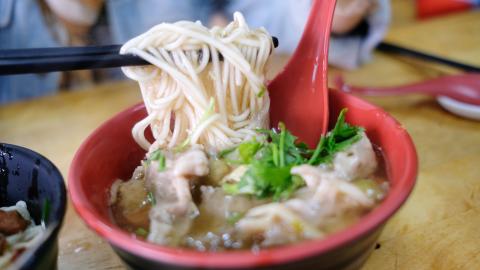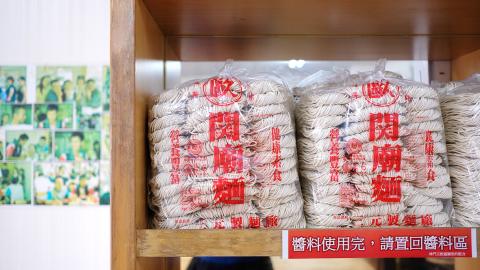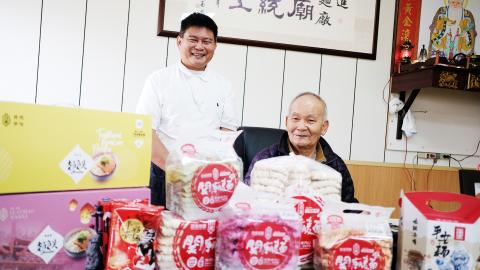It’s eight in the morning on New Year’s Eve, and Yang-Hsing nan (楊幸男) is the only person on the Hochin Guanmiao Noodle (合進關廟麵) factory floor.
Workers, all 15 of them, have been sent home to usher in the new year with family. Only the sprightly Yang, who is in his 70s, turns up to watch over the factory. After all, it’s not too different from home — the business that he set up in 1974 is based on a trade he learned from his father-in-law and is now run by his two sons.
Yang is a man who believes in the next generation. He gestures to a stylish packet of noodles with seasoning — a novelty for the noodle manufacturer.

Photo: Davina Tham, Taipei Times
“At first I didn’t want to [add seasoning], but my son said that if we don’t, we wouldn’t be able to keep up with the times,” he says.
The noodles remain a homespun tradition, mixed from flour, salt and water and sundried over two and a half days, during which they are turned over in their bamboo sieves every two hours.
DAVID AND GOLIATH

Photo: Wu Chun-feng, Liberty Times
The noodle-making industry is not without its dramas. There is a sense of David and Goliath about the competition that traditional noodle-makers face from conglomerates.
The answer is to insist on retaining the unique sundried characteristic of guanmiao noodles, says Yang Chin-lung’s (楊欽龍), Yang Hsin-nan’s eldest son.
“The sundrying process is what gives the noodles a particular flavor and fragrance,” Yang Chin-lung says.

Photo: Davina Tham, Taipei Times
Corporate competitors know all too well the value of the guanmiao name, even as they seek shortcuts to the time and labor-intensive traditional method of making noodles.
Yang notes that some noodle products using the guanmiao brand — which cannot be trademarked, as a place name — are made in other parts of Taiwan and only partially sundried, with the process finished off through baking or frying.
It becomes even more difficult to keep the business afloat when the weather becomes a liability.

Photo: Davina Tham, Taipei Times
Yang says that climate change and extreme weather patterns can cause rains that last for two or three weeks, halting production at the factory.
“What can you do then?” Yang says.
To keep up demand, Yang is courting Din Tai Fung (鼎泰豐) and Tu Hsiao Yueh Tan-tsai Noodles (度小月擔仔麵), famous restaurant chains that have visited Hochin’s factory in their search for noodle suppliers. Netting a partnership with one of these prestige brands would be a big catch that will keep Hochin and its employees well-fed.
He is also trying to improve marketability without sacrificing quality. For example, while some customers — especially Japanese — like that guanmiao noodles are exposed to the elements during the drying process, others have expressed concerns about hygiene. To assuage these concerns, Yang installed golf range netting above the open-air drying area in his factory to keep out airborne pests and birds.
Hochin and other guanmiao noodle producers have started introducing noodles flavored and colored with ground turmeric, red quinoa and even mango and pink dragonfruit, in a bid to amplify the visual, flavor and health quotients all at once. But for locals who grew up on the staple, nothing will replace the original noodle.
A BRIEF HISTORY of GUANMIAO NOODLES
Guanmiao noodles (關廟麵) — named after Guanmiao District (關廟) in Tainan where they are made — have been a staple of the region for generations.
Yang says that locals would bring the noodles with them when they traveled, or give them to friends and relatives. The noodles made ideal gifts as they kept for a long time and were tasty, cheap and simple to cook.
Yang Hsin-nan established Hochin in 1974, having picked up the craft of noodle-making from his father-in-law Li Chin-sheng (李金生), who is credited for being among the first to recognize the commercial potential of guanmiao noodles as a local specialty, establishing the Hsiehchin Noodle Factory (協進製麵廠) in 1952.
Guanmiao’s leading industry used to be the manufacture of rattan products from Indonesian palms. In the 1950s, palm exports ceased as post-colonial Indonesia sought to strengthen domestic manufacturing in pursuit of homegrown economic growth.
“During that time, it so happened that this area had no other industry that people could develop or push,” Yang Chin-lung says. Unmoored from their traditional livelihoods, Guanmiao’s breadwinners began to seek alternatives.
Today, the Hsiehchin brand is shared by three other noodle businesses around town, which belong to the families of Li’s sons. They sustain a peaceful coexistence, bonded by the common challenge of facing off against large-scale mechanized production.
FIT FOR A BANQUET
Guanmiao noodles are used in an assortment of local dishes, but a quintessential form is lu noodles (魯麵) bathed in a thick, starchy gravy topped with meat and vegetables. The firm texture of guanmiao noodles stands up well to the slippery gravy.
Restaurant owner Wang Ya-chun (王雅君) took over the Lin Family Egg Dumplings (林門玉餃) restaurant from her grandfather and mother. The restaurant remains a family affair, using only guanmiao noodles made by two of Wang’s aunts.
On New Year’s Eve, regulars hunch over piping hot bowls of traditional lu noodles topped with sharkmeat nuggets and bamboo shoots.
Wang says that lu noodles would traditionally form the first course in a banquet for early well-wishers to eat their fill. Any leftovers would be packed up and taken home to feed the family.
Ultimately, the taste of home is what keeps the guanmiao noodle-making industry and family-run restaurants in the district going.
Wang says that she still recalls the taste of the lu noodles that she ate as a child. When she finds that flavor from her childhood, she says, “that’s a happy moment.”

In Taiwan there are two economies: the shiny high tech export economy epitomized by Taiwan Semiconductor Manufacturing Co (TSMC, 台積電) and its outsized effect on global supply chains, and the domestic economy, driven by construction and powered by flows of gravel, sand and government contracts. The latter supports the former: we can have an economy without TSMC, but we can’t have one without construction. The labor shortage has heavily impacted public construction in Taiwan. For example, the first phase of the MRT Wanda Line in Taipei, originally slated for next year, has been pushed back to 2027. The government

July 22 to July 28 The Love River’s (愛河) four-decade run as the host of Kaohsiung’s annual dragon boat races came to an abrupt end in 1971 — the once pristine waterway had become too polluted. The 1970 event was infamous for the putrid stench permeating the air, exacerbated by contestants splashing water and sludge onto the shore and even the onlookers. The relocation of the festivities officially marked the “death” of the river, whose condition had rapidly deteriorated during the previous decade. The myriad factories upstream were only partly to blame; as Kaohsiung’s population boomed in the 1960s, all household

Allegations of corruption against three heavyweight politicians from the three major parties are big in the news now. On Wednesday, prosecutors indicted Hsinchu County Commissioner Yang Wen-ke (楊文科) of the Chinese Nationalist Party (KMT), a judgment is expected this week in the case involving Hsinchu Mayor Ann Kao (高虹安) of the Taiwan People’s Party (TPP) and former deputy premier and Taoyuan Mayor Cheng Wen-tsan (鄭文燦) of the Democratic Progressive Party (DPP) is being held incommunicado in prison. Unlike the other two cases, Cheng’s case has generated considerable speculation, rumors, suspicions and conspiracy theories from both the pan-blue and pan-green camps.

Stepping inside Waley Art (水谷藝術) in Taipei’s historic Wanhua District (萬華區) one leaves the motorcycle growl and air-conditioner purr of the street and enters a very different sonic realm. Speakers hiss, machines whir and objects chime from all five floors of the shophouse-turned- contemporary art gallery (including the basement). “It’s a bit of a metaphor, the stacking of gallery floors is like the layering of sounds,” observes Australian conceptual artist Samuel Beilby, whose audio installation HZ & Machinic Paragenesis occupies the ground floor of the gallery space. He’s not wrong. Put ‘em in a Box (我們把它都裝在一個盒子裡), which runs until Aug. 18, invites